Related Research Articles

Kilchurn Castle is a ruined structure on a rocky peninsula at the northeastern end of Loch Awe, in Argyll and Bute, Scotland. It was first constructed in the mid-15th century as the base of the Campbells of Glenorchy, who extended both the castle and their territory in the area over the next 150 years. After the Campbells became Earls of Breadalbane and moved to Taymouth Castle, Kilchurn fell out of use and was in ruins by 1770. It is now in the care of Historic Environment Scotland and is open to the public in summer.
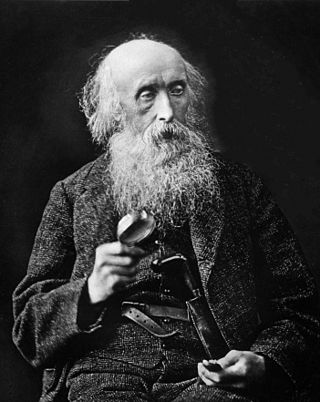
John Hutton Balfour was a Scottish botanist. Balfour became a Professor of Botany, first at the University of Glasgow in 1841, moving to the University of Edinburgh and also becoming the 7th Regius Keeper of the Royal Botanic Garden Edinburgh and Her Majesty's Botanist in 1845. He held these posts until his retirement in 1879. He was nicknamed Woody Fibre.

The Royal Botanic Garden Edinburgh (RBGE) is a scientific centre for the study of plants, their diversity and conservation, as well as a popular tourist attraction. Founded in 1670 as a physic garden to grow medicinal plants, today it occupies four sites across Scotland—Edinburgh, Dawyck, Logan and Benmore—each with its own specialist collection. The RBGE's living collection consists of more than 13,302 plant species, whilst the herbarium contains in excess of 3 million preserved specimens.
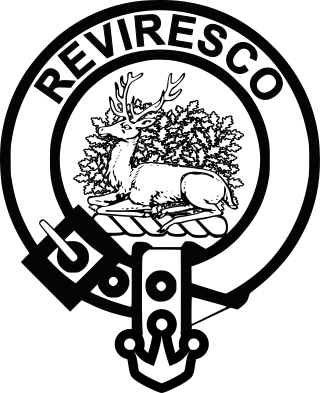
Clan Maxwell is a Scottish clan of the Scottish Lowlands and is recognized as such by the Lord Lyon King of Arms. However, as the clan does not currently have a chief, it is considered an armigerous clan.
His Majesty's Botanist is a member of the Royal household in Scotland.

William Gordon, 6th Viscount of Kenmure and Lord Lochinvar was a Scottish Jacobite.

Clan Sinclair is a Highland Scottish clan which holds the lands of Caithness, the Orkney Islands, and the Lothians. The chiefs of the clan were the Barons of Roslin and later the Earls of Orkney and Earls of Caithness.

Clan Erskine is a Scottish clan of the Scottish Lowlands.
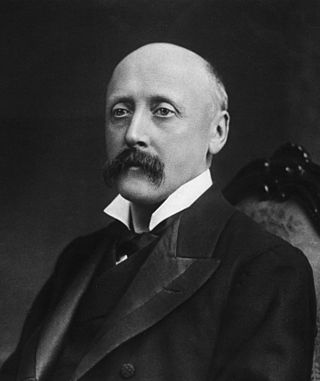
Sir Isaac Bayley Balfour, KBE, FRS, FRSE was a Scottish botanist. He was Regius Professor of Botany at the University of Glasgow from 1879 to 1885, Sherardian Professor of Botany at the University of Oxford from 1884 to 1888, and Professor of Botany at the University of Edinburgh from 1888 to 1922.
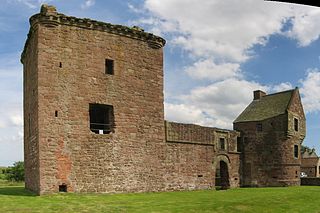
The remains of Burleigh Castle are located just outside the village of Milnathort, 1.5 miles north of Kinross, in Perth and Kinross, Scotland. The castle dates from the 15th and 16th centuries, and now sits beside the A911 road, opposite a 19th-century steading, recently adapted into housing.

Clan Lindsay is a Scottish clan of the Scottish Lowlands.
John St Clair, Master of Sinclair was a Scottish Army officer and Tory politician who sat briefly in the British House of Commons in 1708 before he was excluded as ineligible as eldest son of a Scottish peer. He was court-martialled and under sentence of death for the killing of two fellow officers before he escaped to serve in the Prussian army and was subsequently pardoned. He then took part as a rebel in the Jacobite Rising of 1715 and was attainted and excluded in succession to his father's property. He wrote a personal memoir of the Rising and returned to Scotland after ten years in France and the Low Countries.
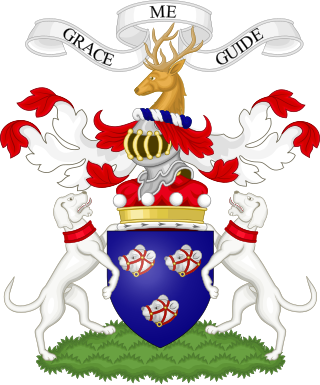
Clan Forbes is a Highland Scottish clan from Aberdeenshire, Scotland.
Sir William Wright Smith FRS FRSE FLS VMH LLD was a Scottish botanist and horticulturalist.
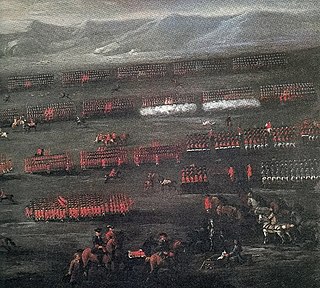
The Jacobite rising of 1715 was the attempt by James Edward Stuart to regain the thrones of England, Ireland and Scotland for the exiled Stuarts.

The siege of Brahan took place in Scotland in November 1715 and was part of the Jacobite rising of 1715. Highlanders loyal to the British-Hanoverian government of George I of Great Britain laid siege to Brahan Castle, seat of William Mackenzie, 5th Earl of Seaforth, who was a staunch Jacobite, loyal to the House of Stuart.
Robert Rollo, 4th Lord Rollo was a Scottish nobleman and Jacobite.

Sir Alexander Erskine of Cambo, 2nd Baronet of Cambo, Fife was a Scottish baronet and Lord Lyon, King of Arms.
The Royal status of the Royal Botanic Garden Edinburgh (RBGE) is intrinsically linked to the issue of a Royal Warrant to the first Intendant of the Gardens in 1699. Since that date, the appointment of each new Director of RBGE has required the assent of the reigning monarch of the United Kingdom, the appointee receiving the unique title RegiusKeeper.

William Keith, 2nd Earl of Kintore, was a Scottish nobleman.
References
- 1 2 Balfour, Isaac Bayley (1913). "A sketch of the Professors of Botany in Edinburgh from 1670 until 1887". In Oliver, Francis Wall (ed.). Makers of British Botany. Cambridge University Press.
- 1 2 3 4 5 6 7 8 9 10 11 12 Balfour, Bayley (1917). "William Arthur, M.D., Botanist To The King In Scotland, 1715–1716". Transactions of the Botanical Society of Edinburgh. 26 (1–4): 375–404. doi:10.1080/03746601709469341 . Retrieved 22 October 2021.
- ↑ Also known as Drummond of Bahaldie
- ↑ "NEWSLETTER EN-21" (PDF).